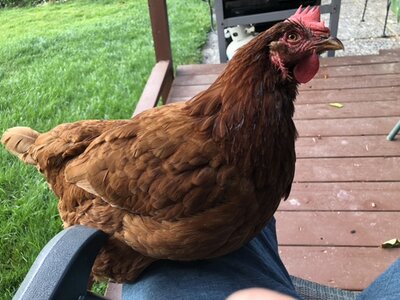Hey all,
I’ve posted a couple of times previously on the health journey of Ruby, a 2.5 year old Rhode Island Red. The first sign of problems was back in January or February when she abruptly stop laying. Then in June she took a nose dive and would barely move. After doing some research I suspected she was internal laying and developed peritonitis. I took her to the vet, and he said she actually had pneumonia, and put her on .2ml of Enrofloxacin twice daily for 15 days. It worked like a charm and she sprang back to life. After a few weeks she started laying again, but shelless eggs. It was an every other day occurrence for a total of 3 “eggs.” Then she stopped. A few weeks later she showed symptoms of being sick again. I took her to the vet and he confirmed she had fluid build up in her and it was infected. He drained 100 ml of fluid, and put her on .2ml of Enrofloxacin once daily for 30 days. We’re 22 days in and she is back to her normal energetic, loving self. No eggs of any kind.
My question if we learn how to drain her and keep her on antibiotics how long can she keep going for? She’s seems to be a fighter, and is definitely a pet at this point. It would be very sad to lose her, but I’m not sure I want to spend hundreds more on her, and I care that she isn’t suffering.
Is there another antibiotic that I could use that is effective but I don’t need to get from the vet?
Any other ideas? I’ve read about hormone implants but that seems to be a bridge too far for my finances.
I’ve posted a couple of times previously on the health journey of Ruby, a 2.5 year old Rhode Island Red. The first sign of problems was back in January or February when she abruptly stop laying. Then in June she took a nose dive and would barely move. After doing some research I suspected she was internal laying and developed peritonitis. I took her to the vet, and he said she actually had pneumonia, and put her on .2ml of Enrofloxacin twice daily for 15 days. It worked like a charm and she sprang back to life. After a few weeks she started laying again, but shelless eggs. It was an every other day occurrence for a total of 3 “eggs.” Then she stopped. A few weeks later she showed symptoms of being sick again. I took her to the vet and he confirmed she had fluid build up in her and it was infected. He drained 100 ml of fluid, and put her on .2ml of Enrofloxacin once daily for 30 days. We’re 22 days in and she is back to her normal energetic, loving self. No eggs of any kind.
My question if we learn how to drain her and keep her on antibiotics how long can she keep going for? She’s seems to be a fighter, and is definitely a pet at this point. It would be very sad to lose her, but I’m not sure I want to spend hundreds more on her, and I care that she isn’t suffering.
Is there another antibiotic that I could use that is effective but I don’t need to get from the vet?
Any other ideas? I’ve read about hormone implants but that seems to be a bridge too far for my finances.




